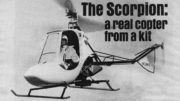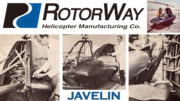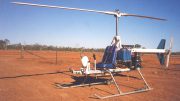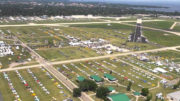Discussions Over The LoneStar Kit Helicopter

Ken Rehler flying the Lonestar kit helicopter
The evolution of the LoneStar kit helicopter shows us that sport helicopters and homebuilt helicopters will always remain a popular subject. Ken Rehler and Tom Carlson took a vision and brought it to completion making available joy of affordable flight.
From the initial design incorporating traditional flight controls on tricycle landing gear to the last version sporting traditional skid landing gear and through-shaft rotor controls, the design of the LoneStar has been a journey in itself.
PIONEER HELICOPTER DESIGNER, B.J.SCHRAMM, QUESTIONS CONTENTS OF LON LAWRENCE’S ARTICLE ON THE LONESTAR KIT HELICOPTER
Dear Norm:

B.J. Schramm
This letter is in response to Lon Lawrence’s article on the Lone Star single place helicopter in the January issue of Sport Pilot Hot Kits & Homebuilts. Normally, when I read an article which has questionable statements, I bite my tongue and just carry on; this time I can’t.
I do not want to discourage Mr. Lawrence from continuing to write future articles on helicopters, however; so at the outset I want him to know that he can call me any time he wishes to discuss any technical subject about which he may have a question. There are ten statements I object to, and because of the technical nature of several of them, this letter may get to be longer than the article.
Here are my comments:
1. Lon states that the bird is finally finished and a phone call confirmed it is going to fly this weekend! What Lon should have said was something like, “The first engine start up is due to take place this weekend!” The public has no comprehension of how long it takes to flight-test a new rotorcraft design, even if Bell Helicopter engineers and test pilots are doing the development work. In the late fifties, I also built my first prototype single-place in six months, but it was over six years and three machines later before I could honestly say it was flying anywhere close to the way a self-respecting helicopter should. Tom Carlson and Ken Rehler don’t have to solve the power plant problems I had, but all the drive harmonics and rotor system dynamics problems must still be overcome.
EDITOR: With respect to the founder of Rotorway Helicopters and all his contributions to the field of rotorcraft, I highly suggest this is comment has little basis and is more of a sore point that back in the day, B.J. did it harder than today. Now there is more advanced technology allowing better quality parts and more accurate “pre” calculations resulting in “more” helicopters getting airborne quicker. To back this, I refer you to B.J’s own design, the Helicycle kit helicopter. While the early Scorpion helicopter may have taken him six years plus, the Helicycles time-to-air, or sale for that matter, was significantly faster. To add, speculation as to whether there had been any earlier engine run-ups or drive train testing had NOT been discussed.
2. The statement is made that “since no welding is required, this lets you get into the air more quickly.” This statement would have some relevance if this was a tube-and-fabric airplane. A helicopter is an endless jumble of machine parts, all of which seem to have mighty close tolerances (+ or – .001/.005). Putting all these together without damaging them in the process is what consumes a helicopter builder’s time. Even if the assemblies are complete, getting them aligned properly in the airframe takes a lot more finesse than the usual eyeball engineering.
EDITOR: Again, B.J. speculates here as the reference is purely to the manufacture of the helicopters airframe, nothing else. It mearely states that as with some other design aircraft, welding of the airframe is required. With this design, that step has been taken out so obviously SAVING TIME! It isn’t to say any other part of the process has been short cut. I often wonder what his opinion of the AW95 was? or maybe even the Mosquito Air ultralight helicopter??
3. At the bottom of page 25, Lon states that “since it (the LoneStar Kit Helicopter) has wheels instead of skids, ground-handling is a breeze!” This 6 MAY 1991 / SPORT PILOT may be true from a ground-handling standpoint only, but, otherwise, the statement is misleading. Two related factors of major importance must be addressed in gear design:
a) Energy absorption
b) Response to autorotative touchdown
There are several others, but these two are of vital importance. Drop tests for a wheeled gear are much more difficult, both from a proof test and from a design standpoint. Getting the gear stiffness requirements to avoid the applicable rotor frequencies can be a lot of time-consuming work. In addition, in the likely event of a hard landing, it’s imperative that the pilot have some spinal protection. The Lone Star design has the pilot sitting right on top of a longitudinal spar. This means the rear gear legs have to do the whole protection job. From the photos, it appears the gear is strut-welded into the frame itself. OUCH!
EDITOR: Wheeled tricycle landing gear is STILL used an some commercial helicopters today, properly designed, they absorb impact as well as any other helicopter. In saying this, I would agree with a run-on landing in any state would be dubious – (especially on anything but a sealed surface), and that is why Ken and Tom quickly changed to skid type landing gear, as did B.J. himself with the first Scorpion One helicopter – just after the Javelin helicopter prototype. Maybe he forgot that he himself once developed a helicopter with tricycle gear before moving to traditional skids?
4. The performance claim of an “out-of-ground-effect hover at 650 pounds” is made. Lon should have said that, “Some day, the designers hope to achieve this performance!” A rule-of-thumb helicopter design factor says we probably lift 10 pounds for each horsepower, depending largely on what our disc loading is. Most light helicopters (including the Rotorway machines) have better power/weight ratios than this, and a sea level in-ground-effect hover is hard enough at gross load for some of these machines. “V” belts have an approximate 7 percent power loss per interface, gears are substantially less at 1-1/2 percent and roller chain approximately one percent, depending on design. If a Rotax 582 made 60 hp on a properly-calibrated dyno at 6100-6300 rpm (where it will live), I’d be happily surprised. Deduct only the Lone Star first stage drive losses, and you have 55.8 hp, or 11.65 pounds per hp. By now, I think you’re beginning to see the problem.
EDITOR: Again, here B.J. does not take into account the composite rotorblade efficiency when compared to his riveted aluminum blades. The life factor should be around 12 lbs/hp still keeping within flight parameters. In comparison to B.J’s Rotorway Execs with 2 people and full fuel that would exceed these parameters, and sometimes not even being able to leave the ground! Again, the LoneStar Kit Helicopter did fly this way quite happily, and had (as far as I know “till today”), a 100% safety record. Compare that to any other kit helicopter – regardless of numbers, if it’s a good flyer and design operated by proficient pilots – there’s no argument. As it turned out, for high altitude flying and heavier pilots, higher horsepower engines were later offered. Something that Rotorway never considered (except for the Scorpion One – (85 HP or 115 HP options).
5. Next, Lon says, concerning the autorotation clutch, that, “It has no external controls and disengages automatically!” No autorotation clutch has external controls. Two types of over-running clutches are commonly employed in helicopters. They include sprag and roller types. It might be of interest for you to know that, due to the fact that no commercial U.S. sprag clutch manufacturer would sell their units for aircraft use, Rotorway had to start building their own clutches in the 80s. If LoneStar is not using clutches of its own design now, the 120-day kit delivery time may quickly evaporate.
EDITOR: Commercial sprag clutches are freely available commercially – just don’t mention from the retailer what they will be used for due to liability issues! Lon was reporting to the general aviation public, many of which are fixed wing pilots that often ask – “what happens if the engine quits?” He does not assume that every person reading the article is fluent in the mechanics of a helicopter in any form. A polite gesture from an aviation reporter? As for the 120 day kit delivery suggestion – this was made possible by Ken being smart enough to shop out his work to professionals in their fields. He simply had to action an order and put the kit together ready for shipping!
6. Statements about the rotors include: “The rotor blades are composite and therefore provide unequaled strength and are not subject to the same fatigue factor as metal blades!” Composite is not a magic word. Rotor system design centers around proper stiffness. Correct stiffness can theoretically be achieved with any material, from wood to titanium. The proof of this rotor, and any other rotor, will be in its stability and longevity.
Some of the stability requirements include:
a) Ground and air resonance (lack of)
b) Torsional stability
c) Whirl mode stability
d) Rotorweave resistance
e) Blow-back stability
I seriously doubt that the corners of the flight envelope which encompass all of the above will be known by the Lone Star designers for months, if not years. So you see, the word “composite” has very little to do with rotor blade stability or safety. The weather problem, by the way, has nothing to do with the rotors at rest. The real weather question occurs at the 400 mph tip speed, where water or sand erosion occurs on the blade leading edge. (One of Desert Shield’s — now Desert Storm’s — biggest helicopter maintenance problems.)
EDITOR: There rotorblades of the LoneStar Kit Helicopter are the well proven Mc Cutchen – Skywheels design, the same that are standard on Safari kit helicopters today (who now manufactures them). Hundreds of thousands of flight hours on helicopters and gyrocopters – thus, a miss-informed comment. Yes, they must be suitable to the craft they are being fitted to – in this case I’d say an overwhelming success! They also exhibited superior performance with their curved blade tips (earlier models) reducing tip losses and improving airflow vortices. Being “composite” means being constructed of different materials – usually epoxies, fiberglass and other exotic materials. In this case, the blade uses an aircraft grade aluminum main spar with a tough carbon fibre type composite skin bonded to the blade. In this case, there would no longer be an infinite life due to the aluminum spar – though the rigidity of the composite skin would definitely contribute to a significantly increased life expectancy.
As to the erosion problem with composite blades – nearly all rotorcraft today are leaning towards composite blades, to protect them in wet, dusty or otherwise harsh environments, they fit high-tech leading edge protection tape, thus addressing the potential problem of lead edge breakdown. Some military versions even came out with a thin stainless leading edge skin.
7. Now for the straw that broke the earners back: I wasn’t going to write this letter until I came to this statement: “One of the really neat things I liked;” Lon says about the Lone Star, “is the fact that the tail and tail rotor do not extend past or behind the main rotor!” First, let me ask you, have you ever seen a commercial single-rotor helicopter with its tail directly under the main rotor?
Here are some reasons why not:
a) Flow interaction. In a hover, the main rotor wake will drive tail-rotor inflow crazy, not to mention the added effect of quartering or crosswinds.
b) The low position of the tail rotor in respect to the main rotor creates a torque moment which is compensated for by tilting the rotor disc laterally in the opposite direction.
In the case of the LoneStar Kit Helicopter, this moment is greatly exaggerated by the shorter tail boom. The first time a test pilot flies the Lone Star through translation (past approximately 25 mph), he’d better be on his toes (literally). Lateral cyclic forces will be severe in a hover, so when translation speed is reached, a pretty exciting scenario will quickly develop. I predict that one of the first changes by the Lone Star folks will be to lengthen and raise the tail boom. Of course, this will complicate the tail rotor drive system. The single-drive belt will
not be long enough, the CG will change, and so it goes. (I’ve been there!)
EDITOR: Case and point, the early Adams Wilson Flying Triumph AKA “Choppy” design encompassed the same short tail boom set-up – “and flew”. Next, see our video galleries for the LoneStar kit helicopter YouTube video “flying” with the short tail boom! (Take-off, hover and transitional low level flight and flying the pattern). Yes, it might be common practice but it has been done before – and on other helicopters to such as the FireBird and others. Having a longer tail boom does give you better tail rotor authority, but that’s not to say it’s the “golden rule” of tail boom design for all helicopters…

LoneStar helicopter anti-torque pedals
8. “The Lone Star sports all standard controls so you can transition without any negative learning curve!” Oh, boy! Having flown many types of helicopters, from those of my own design to the Sikorsky Black Hawk, I can loudly insist that no two are alike. Some are not even close! Some wander in a hover, all have different autorotational flare characteristics and flare heights. Some have translational vibration tendencies, and some do not. Control harmony differs from ship to ship, and so on.
The only successful way to train a helicopter pilot is to do it “in type;” and I’ll grant you that this is harder to do in a single-place machine, but this obstacle can be overcome. Shoving an unwitting student, however, directly out the door of a Robinson R-22 and into the Lone Star to teach himself autorotations is sheer madness!
EDITOR: I’d like to know how B.J. did it with his own single seat helicopters then? As to the “standard controls” as quoted is correct, there is the standard cyclic control stick that is floor mounted (some were overhead or side mounted!). The Nolan coaxial helicopter had “technically” no collective and relied on engine to rotor rpm for vertical height changes. The author wasn’t trying to over-simplify flying a helicopter, just making a point that it was a true helicopter in every sense, with the same controls as any other helicopter. Also, BJ had the Scorpion 1 and the Helicycle “single seat” helicopters – he must have also forgot this when criticizing the LoneStar Kit Helicopter. Again, just reporting the facts against what others “may” have heard about some of these kit helicopters coming out of the works!

Simple – but effective! LoneStar helicopter pedal frame mount
9. Lon says “The sales price of $17,950 is guaranteed”! By whom or what? This animal has yet to really fly! I’m not sure that any helicopter manufacturer ever completed a flight test program and filled a production pipeline of “frozen design” parts in anything less than years, much less in 120 days.
OK, so a useless statement of “guaranteeing” a price, but who hasn’t done that in their maketing campaign? I recall at some stage the Mini 500 quoting a “fixed price” – of course with a disclaimer of “subject to change” and costly additional add-ons! It brings in customers and gives them a fair idea that the price will be around “that figure”. A point that need not be challenged!

LoneStar helicopter tailrotor assembly
10. Lastly, I sincerely appreciate the hard work the Lone Star designers have gone to, in order to get their promising project this far. What I do object to is the false hopes which Lon (quite unwittingly, no doubt) may create in the minds of potential purchasers, stating that “If you’d like to beat the rush, get your order in early !” I believe it’s the duty of the manufacturer to do the selling, and that of the writer to report accurately. Every new product which comes along should be given a fair evaluation.
Sincerely,
B.J. Schramm
EDITOR: The writer is partially expressing their OWN opinion – sometimes unwittingly biased – none the less, “their” opinion as a writer/reporter. I’m sure Lon was so impressed as an individual with the LoneStar kit helicopter, he expected many sales to follow. He did not say this was the safest, most affordable, easy to fly, proven design – just that it was expected to have a lot of units sold.

LoneStar helicopter belt drive transmission
P.S. Please don’t take this letter as anything but constructive criticism. Sport Pilot Hot Kits & Homebuilts is doing a great job and I hope it continues forever. I enjoy each and every issue
Dear B.J., Thanks for writing; it was wonderful hearing from you. Readers who may not already be aware of the fact, should know that you are one of the pioneers of the personal helicopter industry, and you’ve devoted the greater part of your life to developing an efficient, but safe, small helicopter.
Our writer, Lon Lawrence, a college student who also loves gyroplanes, has in fact, recently finished building a two passenger one for himself. He lives in the mountains of New Mexico, and, in a recent conversation he told me that he’s discovering the negative effects of high altitude on the percentage of horsepower on engines and on the lifting quantity of aircraft.
I have a feeling that, as soon as Lon reads your letter in this issue, he’ll pick up the phone and give you a call. Such is the enthusiasm of youth. (As far as I can remember.) It was wonderful hearing from you and we wish you the very best of luck in whatever business ventures you embrace in the future. SP
Editor: It’s a shame this discussion was never resolved as both Ken and B.J. are now deceased. B.J. lost his life while flying his last design, the Helicycle single seat kit helicopter in circumstances unknown, crashing in a river. Ken lost his life in his original design twin tail gyrocopter in what was believed to be a weather induced accident (wind gust).

The LoneStar Kit Helicopter prototype – pre – upper rotor shaft support improvement.
The LoneStar was created in three (3) different versions – the first being an all steel airframe with tricycle wheel landing gear.
This was soon changed to traditional style “skid” type landing gear. After that was the first of the final layout – a through shaft swashplate control system with bolt-together aluminum airframe.
This model was later to have an upper rotor mast support update and increased engine horsepower options, but basically remained the same.
- Subject: helo
- Date: Mon, 7 Dec 1998 09:21:03 -0600
- From: “Dcomp”
- To: SHnPGIE
I have been considering building a helo (kit or plans) I have really enjoyed your website emmensly. It is very infomative and MOST of the links work (a couple of old links). I was considering a Lone Star kit (I flew a completed kit in California). Nice and smooth to fly, well put togeather but I have not been able to find the company URL. I’ve tried every known way to search for it but have yet to get ahold of them.
Dear B.J., Thanks for writing; it was wonderful hearing from you. Readers who may not already be aware of the fact, should know that you are one of the pioneers of the personal helicopter industry, and you’ve devoted the greater part of your life to developing an efficient, but safe, small helicopter.
Our writer, Lon Lawrence, a college student who also loves gyroplanes, has in fact, recently finished building a two passenger one for himself. He lives in the mountains of New Mexico, and, in a recent conversation he told me that he’s discovering the negative effects of high altitude on the percentage of horsepower on engines and on the lifting quantity of aircraft.
I have a feeling that, as soon as Lon reads your letter in this issue, he’ll pick up the phone and give you a call. Such is the enthusiasm of youth. (As far as I can remember.) It was wonderful hearing from you and we wish you the very best of luck in whatever business ventures you embrace in the future. SP
Editor: It’s a shame this discussion was never resolved as both Ken and B.J. are now deceased. B.J. lost his life while flying his last design, the Helicycle single seat kit helicopter in circumstances unknown, crashing in a river. Ken lost his life in his original design twin tail gyrocopter in what was believed to be a weather induced accident (wind gust).

The LoneStar Kit Helicopter prototype – pre – upper rotor shaft support improvement.
We have released more LoneStar Kit Helicopter technical photos to compliment the updated “Partial Plans” eBook download available for purchase (more details the plans section of our website).
The LoneStar was created in three (3) different versions – the first being an all steel airframe with tricycle wheel landing gear.
This was soon changed to traditional style “skid” type landing gear. After that was the first of the final layout – a through shaft swashplate control system with bolt-together aluminum airframe.
This LoneStar Kit Helicopter model was later to have an upper rotor mast support update and increased engine horsepower options, but basically remained the same.
- Subject: helo
- Date: Mon, 7 Dec 1998 09:21:03 -0600
- From: “Dcomp”
- To: SHnPGIE
“I have been considering building a helo (kit or plans) I have really enjoyed your website emmensly. It is very infomative and MOST of the links work (a couple of old links). I was considering a Lone Star kit (I flew a completed kit in California). Nice and smooth to fly, well put togeather but I have not been able to find the company URL. I’ve tried every known way to search for it but have yet to get ahold of them”.
PLEASE NOTE: Star Aviation is no longer in existence and the LoneStar kit helicopters are no longer produced. Mr Ken Rehler passed away recently so this is the only known remaining source of information licenced to be advertised and distributed to the public. All property is copyright protected.







Be the first to comment on "B.J.Schramm Challenges The LoneStar Kit Helicopter"